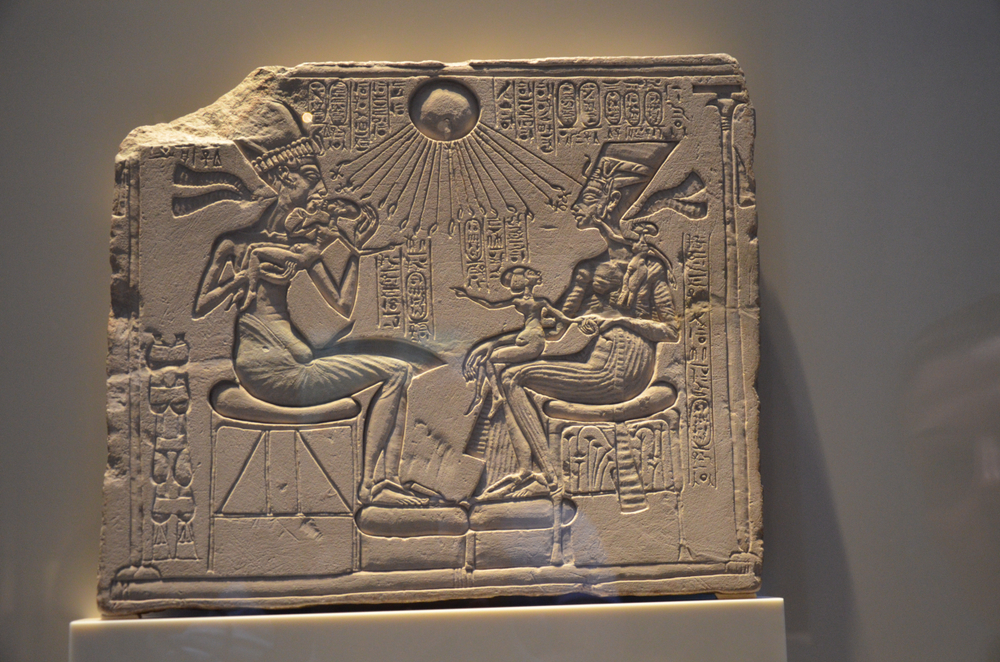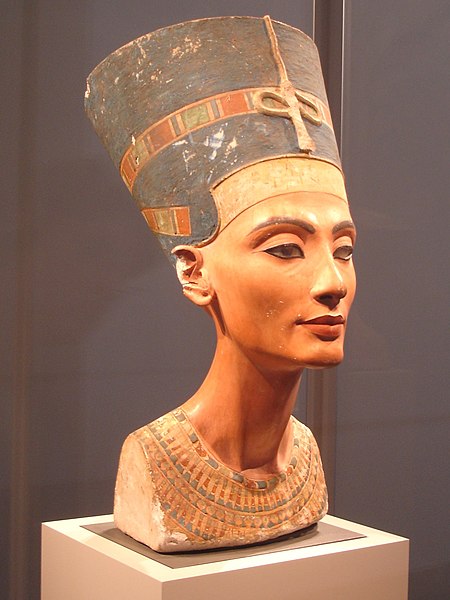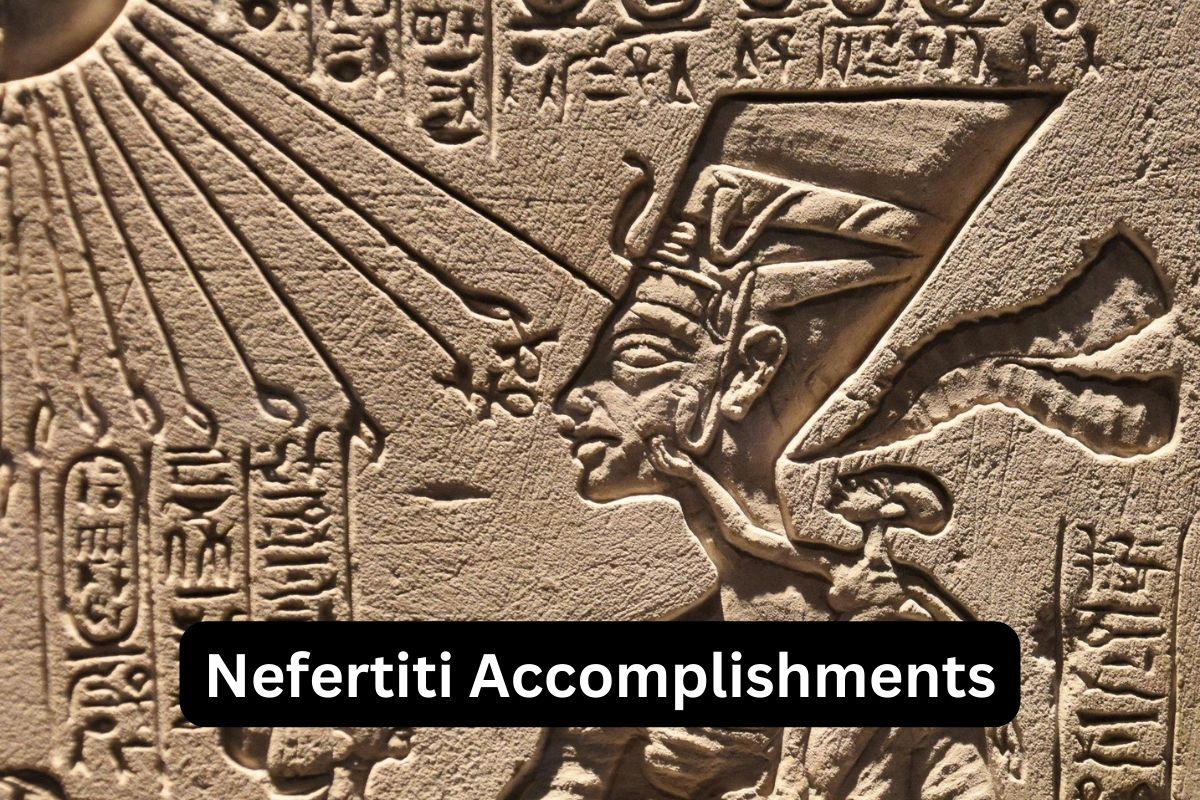Nefertiti was an ancient Egyptian queen who lived during the 14th century BCE. She rose to prominence as the queen consort of Pharaoh Akhenaten, who initiated a religious revolution in Egypt.
Nefertiti played a significant role in promoting the worship of the sun god Aten and co-ruled alongside Akhenaten, exerting considerable power and influence. She was known for her exceptional beauty, which is immortalized in the iconic “Bust of Nefertiti” sculpture.
Nefertiti and Akhenaten established the city of Amarna as the capital of Egypt, bringing about significant changes in religious, political, and artistic spheres. Through her patronage of the arts and diplomatic efforts, Nefertiti left a lasting impact on ancient Egyptian culture and diplomacy.
Despite the mysteries surrounding her ultimate fate, Nefertiti’s legacy endures as an emblem of beauty, power, and cultural innovation in ancient Egypt.
Accomplishments of Nefertiti
1. Promoting religious revolution
Queen Nefertiti played a significant role alongside her husband, Pharaoh Akhenaten, in promoting a religious revolution in ancient Egypt. Together, they introduced a monotheistic belief system centered around the worship of the sun god Aten.
Also Read: Facts About Nefertiti
This departure from the traditional polytheistic religion was a radical change that challenged the established religious order and had a profound impact on Egyptian society and culture.
2. Co-ruling Egypt alongside Pharaoh Akhenaten

As the queen consort of Pharaoh Akhenaten, Nefertiti held considerable power and influence. Together, they formed a powerful partnership in governing Egypt.
Nefertiti actively participated in religious and political affairs, exerting her authority and playing a vital role in shaping the policies and decisions of the kingdom. Her involvement in ruling Egypt contributed to the significant changes that occurred during Akhenaten’s reign.
3. Establishing Amarna as the capital
Nefertiti and Akhenaten decided to relocate the capital of Egypt from Thebes to a newly constructed city called Amarna (also known as Akhetaten). This move was a momentous decision that reshaped the administrative and political structure of the kingdom.
The establishment of Amarna as the capital marked a break from tradition and symbolized the radical changes introduced during Akhenaten’s reign.
Amarna became a center for artistic expression, religious worship, and political activity, reflecting the innovative and progressive ideas promoted by Nefertiti and Akhenaten. The city was a physical manifestation of their vision for a new Egypt.
4. Iconic artistic representations
Nefertiti is renowned for her beauty, and one of the most famous depictions of her is the “Bust of Nefertiti.” This exquisite sculpture showcases her striking features, including her elegantly arched eyebrows, almond-shaped eyes, and gracefully elongated neck.
The bust has become an enduring symbol of ancient Egyptian art and is considered a masterpiece of sculpture. Nefertiti’s portrayal in artistic representations, such as statues and reliefs, captured her timeless beauty and left a lasting impression on ancient Egyptian art.

5. Influencing royal artwork and fashion
Nefertiti’s reign had a profound influence on artistic styles and fashion trends in ancient Egypt. She embraced innovative artistic representations that departed from traditional Egyptian norms. Nefertiti’s distinctive features and regal attire became the model for portraying feminine beauty and grace.
Her elaborate hairstyles, including the iconic flat-topped crown, set a new standard in royal fashion. The queen’s preference for vibrant colors and luxurious fabrics also shaped the clothing and adornments worn by the royal court and aristocracy.
6. Promoting diplomacy
Queen Nefertiti actively engaged in diplomatic relations with other ancient civilizations, demonstrating her political acumen and fostering alliances. Through diplomatic correspondence and exchanges of gifts, she strengthened Egypt’s position in international politics.
Nefertiti’s diplomatic efforts aimed to maintain peaceful relations and secure beneficial agreements, ensuring the stability and prosperity of Egypt. Her involvement in diplomacy showcased her intelligence, strategic thinking, and ability to navigate complex political landscapes.
7. Preserving the royal family legacy
Queen Nefertiti played a crucial role in securing the royal family’s lineage and ensuring the continuity of their reign. She and Pharaoh Akhenaten had six daughters, including the famous Ankhesenamun.
Through her offspring, Nefertiti preserved the bloodline of the royal family and maintained the dynastic succession. The preservation of the royal family legacy was vital in ancient Egyptian society to maintain stability, legitimacy, and the divine connection believed to be associated with the ruling lineage.
8. Influence on female empowerment
Nefertiti’s reign as a powerful queen consort challenged traditional gender roles and stereotypes. Her prominent position alongside Pharaoh Akhenaten showcased the potential for women to hold positions of authority and influence in ancient Egyptian society.
Nefertiti’s significant role in religious, political, and cultural affairs empowered women and inspired a sense of possibility and agency. Her example served as a source of inspiration for future generations of women seeking to break free from societal limitations.
9. Patronage of the arts
Nefertiti was a notable patron of the arts during her reign. She actively supported and encouraged artistic expression in various forms, including sculpture, painting, and architecture.
Nefertiti’s patronage contributed to the flourishing of artistic creativity in ancient Egypt, leading to the creation of remarkable works of art. The queen’s support provided artists with resources and opportunities to showcase their talent, resulting in a vibrant cultural landscape and leaving a lasting artistic legacy.
10. Inspiring fascination and admiration
Queen Nefertiti’s enigmatic beauty, powerful reign, and significant contributions to ancient Egypt have fascinated historians, scholars, and people around the world for centuries.
Her iconic bust, discovered in 1912, captivated the public’s imagination and became an enduring symbol of ancient Egyptian civilization. Nefertiti’s allure and her remarkable achievements continue to inspire admiration, curiosity, and awe. Her reign represents a golden era in ancient Egyptian history and serves as a reminder of the grandeur and cultural richness of the civilization that thrived along the Nile.
